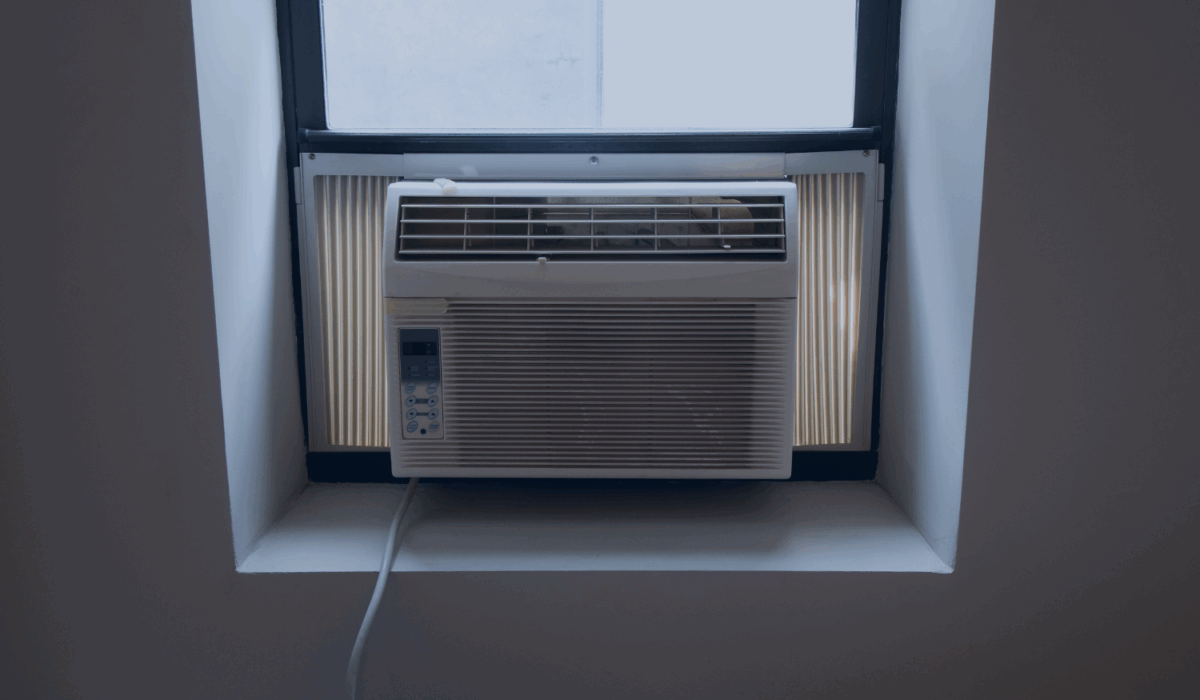Cleaning an air conditioner window unit at home is easier than you think. All you need are a few supplies, some patience, and about 30–60 minutes of your time. A clean unit cools better, uses less energy, and helps keep the air in your home fresh.
How Do You Know When an Air Conditioner Window Unit Needs Cleaning?
Look out for these signs:
- Weak airflow or rooms that take longer to cool
- Musty or damp smells when the unit starts
- Dust or gray film on vents and grilles
- Water dripping where it shouldn’t
- Rattling or buzzing sounds from the fan
- Higher energy bills compared to last summer
These are also common issues home inspectors flag. Catching them early helps you avoid costly repairs.

What Supplies Are Needed to Clean an AC Window Unit?
You don’t need fancy tools to clean a window air conditioner. Most supplies are items you already have at home.
Start with mild dish soap and warm water. These are safe on both the filter and the plastic housing. A microfiber cloth helps trap dust without scratching surfaces.
A vacuum with a brush attachment makes it easy to lift lint and dirt from vents and coils. A soft brush or old toothbrush is handy for scrubbing tight spots.
A spray bottle filled with water or a soapy solution helps with cleaning coils. A bucket or small tub is useful for soaking the filter.
Always wear gloves to protect your hands. A simple mask can also help if you’re dealing with dust or light mold. Lay down towels or a drop cloth under the unit to catch drips.
Optional extras include a fin comb for bent fins, a coil cleaner spray for stubborn dirt, compressed air for tight spots, and white vinegar to freshen the drain pan.
Cleaning your AC filter and coils can lower cooling energy use by 5–15%, according to the U.S. Department of Energy.
Step-by-Step Guide
Follow these steps for a safe, thorough clean:
Before You Begin
Turn the unit off and unplug it from the power source. Lay towels or a drop cloth under the AC to catch drips and dust. Open a window or turn on a fan for ventilation.
Step 1: Remove the Front Panel and Filter
Take off the front panel. It usually clips or unscrews easily. Slide out the filter, then wash it with warm, soapy water. Rinse thoroughly and let it dry completely before reinstalling.
Step 2: Vacuum the Inside
Use the brush attachment on your vacuum to gently remove dust from the vents and coils. Be careful not to press too hard on the aluminum fins, as they bend easily.
Step 3: Clean the Coils and Fins
Lightly mist the coils with soapy water or a coil cleaner spray. Use a soft brush to loosen dirt, brushing in the same direction as the fins. If the fins are bent, straighten them with a fin comb to restore airflow.
Step 4: Clear the Drain Pan and Drain Hole
Check the drain pan at the bottom of the unit. Wipe out any sludge or debris. Spray vinegar into the pan, let it sit for 10 minutes, then wipe clean. Use a pipe cleaner or zip tie to make sure the small drain hole isn’t blocked.
Step 5: Clean the Housing and Fan Blades
Wipe down the fan blades with a damp cloth. Clean the inside of the plastic housing, control knobs, and the front grille to remove dust and grime.
Step 6: Reassemble and Dry
Once everything is clean, reinstall the dry filter and the front panel. Let the unit air dry for at least 30 minutes before plugging it back in.
Step 7: Test the Unit
Turn the unit back on and set it to “Cool.” After a few minutes, check that the airflow feels stronger, the air is cooler, and no musty smell remains.

Safety Precautions When Cleaning a Window AC Unit
Keep these safety rules in mind:
Electrical Safety
- Always unplug the unit
- Keep water away from wires and outlets
- Let the unit dry fully before turning it back on
Water and Cleaner Safety
- Use mild soap or AC-safe coil cleaner
- Avoid bleach inside the unit (harsh and damaging)
- Never mix vinegar and bleach
Structural Safety
- Do not remove the unit alone; it’s heavy
- Handle fins carefully; they are sharp
- Wear gloves and eye protection
Health Safety
- Wear a mask if mold is present
- Call a professional if you notice refrigerant leaks, strong chemical smells, or electrical issues
How Cleaning Helps Your Home in the Long Run
A clean AC runs more efficiently, which means lower energy bills. When airflow is not blocked by dust, the unit doesn’t have to work as hard.
Better cooling is another big benefit. Clean fins and coils efficiently transfer heat, helping rooms cool down quickly and stay comfortable. Clean units also improve indoor air quality. Dust, pollen, and mold are less likely to circulate inside your home when filters and drain pans are maintained.
Regular care extends the lifespan of the AC. Motors, fans, and coils last longer when dirt is not causing strain or overheating.
Keeping the drain pan clear prevents water from leaking into the interior. This protects window sills, drywall, and trim from moisture damage. You’ll also notice quieter operation. Additionally, removing dust and debris from the fan blades helps reduce rattling and vibrations.
Finally, clean AC units look better during a home inspection. A well-maintained system is less likely to be flagged, giving you more peace of mind.
Related Questions
- Can you clean a window AC without removing it?
Yes, filters, vents, coils, and the drain pan can all be cleaned in place. - What happens if you don’t clean your AC?
Airflow weakens, cooling drops, energy bills rise, and mold may grow. - Is vinegar safe inside an AC unit?
Yes, vinegar is safe for the drain pan. Avoid bleach. - How do you prevent mold in a window AC?
Rinse filters monthly, keep the drain hole clear, and run the fan-only setting to dry out moisture and prevent the possibility of mold. - When should you replace an AC window unit instead of cleaning it?
If the unit is 10 years or older, rusty, drips, or still performs poorly after cleaning, replacement may be the best option.
Conclusion
Cleaning a window AC at home is safe, affordable, and effective. With just a few supplies and the steps above, you can enjoy cooler air, better health, and lower energy costs.
If you’re worried about hidden problems, like mold, leaks, or wiring issues, it may be time for a professional check. Schedule a home inspection with Edifice Inspections to catch issues early and keep your home safe and comfortable.


2 Comments
Comments are closed.